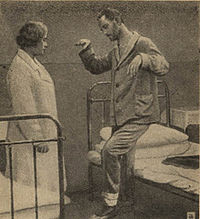
Photo from wikipedia
Background A large amount of literature surrounds the differences between dissociative neurological symptom disorder with non-epileptic seizures (DNSD-S) and epilepsy. Aims To explore the research gap on phenotypic differences between… Click to show full abstract
Background A large amount of literature surrounds the differences between dissociative neurological symptom disorder with non-epileptic seizures (DNSD-S) and epilepsy. Aims To explore the research gap on phenotypic differences between DNSD-S and other psychiatric disorders. Method We conducted a case–control study of 1860 patients (620 patients with DNSD-S and 1240 controls with other psychiatric disorders) seen at the South London and Maudsley Hospital NHS Trust between 2007 and 2019. Results Compared with the controls, the patients with DNSD-S were more likely to be female (76 v. 47%, P < 0.001), of White ethnicity (77 v. 60%, P < 0.001), married (34 v. 14%, P < 0.001) and living in areas of lower socioeconomic status (−3.79, 95% CI −2.62 to −4.96, P < 0.001). Two peaks for age at diagnosis were observed for DNSD-S: the early 20s and late 40s. After 31 years of age, men's chance of being diagnosed with DNSD-S increased from 19 to 28% (P = 0.009). People with DNSD-S presented more commonly with a history of a neurological episodic or paroxysmal disorder (OR = 12, 95% CI 7.82–20.26), another dissociative disorder (OR = 10, 95% CI 1.64– 65.95) or unclassified signs or symptoms (OR = 4, 95% CI 2.61–6.43). Neither anxiety, depression nor other somatoform disorders predicted subsequent diagnosis of DNSD-S, and controls had a larger proportion of preceding psychiatric diagnoses than patients with DNSD-S (65 v. 49%, P < 0.001). Conclusions This is the first study comparing demographic and phenotypic correlates of patients with DNSD-S against a large cohort of psychiatric patients. These data will inform development and drive service needs in psychiatry for people with DNSD-S.
Journal Title: BJPsych Open
Year Published: 2021
Link to full text (if available)
Share on Social Media: Sign Up to like & get
recommendations!